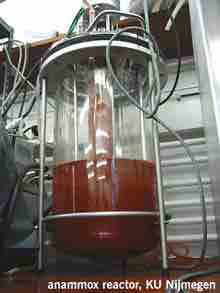Anammox, an abbreviation for ANaerobic AMMonium OXidation , is a globally significant microbial process of the nitrogen cycle. The bacteria mediating this process were identified in 1999, and at the time were a great surprise to the scientific community. Anammox takes place in many natural environments, contributing up to 50% of the dinitrogen gas produced in the oceans. In this biological process, nitrite and ammonium are converted directly into dinitrogen gas. The overall catabolic reaction is:

Enrichment Culture of Anammox Bacterium (Radboud University, Nijmegen)
Enrichment culture of the anammox bacterium, Kuenenia stuttgartiensis.
NH4+ + NO2− → N2 + 2H2O.
This form of metabolism involves the coupling of ammonia oxidation to nitrite reduction. Since oxygen is not required for the process, these organisms are strict anaerobes. Amazingly, hydrazine (N2H4 — rocket fuel) is produced as an intermediate during anammox metabolism. To deal with the high toxicity of hydrazine, anammox bacteria have a hydrazine-containing intracellular organelle called the anammoxasome (a compartment inside the cytoplasm which is the locus of anammox catabolism), which is surrounded by an unusual and highly compact ladderane lipid membrane. Further, the membranes of these bacteria mainly consist of ladderane lipids so far unique in biology. Of special interest is the conversion to hydrazine (normally used as a high-energy rocket fuel, and poisonous to most living organisms) as an intermediate. A final striking feature of the organism is the extremely slow growth rate. The doubling time is nearly two weeks. The anammox process was originally found to occur only from 20°C to 43°C but more recently, anammox has been observed at temperatures from 36°C to 52°C in hot springs and 60°C to 85°C at hydrothermal vents located along the Mid-Atlantic Ridge.
Anammox organisms are autotrophs although the mechanism for carbon dioxide fixation is still unclear. Because of this property, these organisms could be used industrially to remove nitrogen in wastewater treatment processes. The bacteria that perform the anammox process belong to the bacterial phylum Planctomycetes (e.g. Candidatus Brocadia anammoxidans), of which Planctomyces and Pirellula are the best known genera. Currently five genera of anammox bacteria have been (provisionally) defined: Brocadia, Kuenenia, Anammoxoglobus, Jettenia (all fresh water species), and Scalindua (marine species).